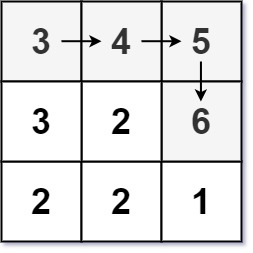LeetCode-in-Java
329. Longest Increasing Path in a Matrix
Hard
Given an m x n integers matrix, return the length of the longest increasing path in matrix.
From each cell, you can either move in four directions: left, right, up, or down. You may not move diagonally or move outside the boundary (i.e., wrap-around is not allowed).
Example 1:

Input: matrix = [[9,9,4],[6,6,8],[2,1,1]]
Output: 4
Explanation: The longest increasing path is [1, 2, 6, 9].
Example 2:

Input: matrix = [[3,4,5],[3,2,6],[2,2,1]]
Output: 4
Explanation: The longest increasing path is [3, 4, 5, 6]. Moving diagonally is not allowed.
Example 3:
Input: matrix = [[1]]
Output: 1
Constraints:
m == matrix.lengthn == matrix[i].length1 <= m, n <= 2000 <= matrix[i][j] <= 231 - 1
Solution
public class Solution {
public int longestIncreasingPath(int[][] matrix) {
int maxIncreasingSequenceCount = 0;
int n = matrix.length - 1;
int m = matrix[0].length - 1;
int[][] memory = new int[n + 1][m + 1];
for (int i = 0; i < matrix.length; i++) {
for (int j = 0; j < matrix[i].length; j++) {
maxIncreasingSequenceCount =
Math.max(maxIncreasingSequenceCount, move(i, j, n, m, matrix, memory));
}
}
return maxIncreasingSequenceCount;
}
private int move(int row, int col, int n, int m, int[][] matrix, int[][] memory) {
if (memory[row][col] == 0) {
int count = 1;
// move down
if (row < n && matrix[row + 1][col] > matrix[row][col]) {
count = Math.max(count, move(row + 1, col, n, m, matrix, memory) + 1);
}
// move right
if (col < m && matrix[row][col + 1] > matrix[row][col]) {
count = Math.max(count, move(row, col + 1, n, m, matrix, memory) + 1);
}
// move up
if (row > 0 && matrix[row - 1][col] > matrix[row][col]) {
count = Math.max(count, move(row - 1, col, n, m, matrix, memory) + 1);
}
// move left
if (col > 0 && matrix[row][col - 1] > matrix[row][col]) {
count = Math.max(count, move(row, col - 1, n, m, matrix, memory) + 1);
}
memory[row][col] = count;
}
return memory[row][col];
}
}

